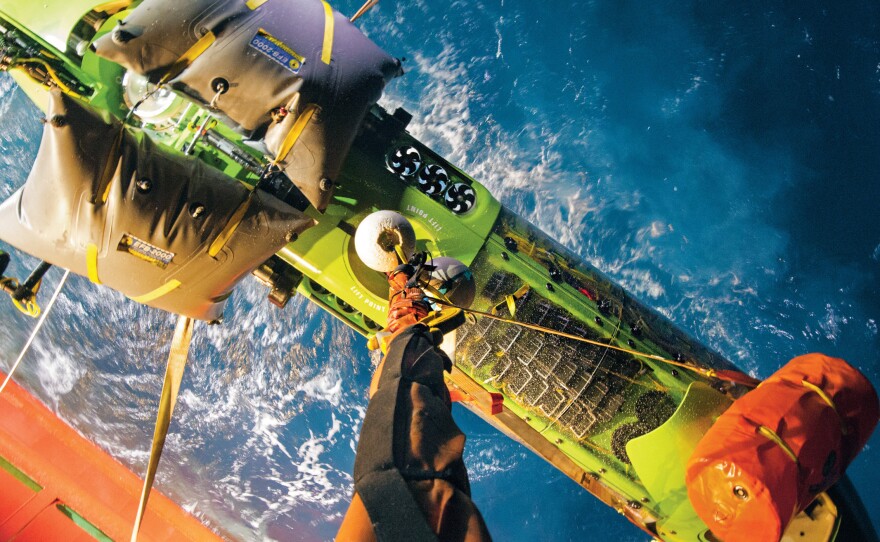




At nearly seven miles below the water's surface, the Mariana Trench is the deepest spot in Earth's oceans. And the site north of Guam is where director and explorer James Cameron recently fulfilled a longtime goal of reaching the bottom in a manned craft.
For the dive, Cameron designed a 24-foot submersible vehicle, the Deepsea Challenger -- "this kind of long, green torpedo that moves vertically through the water," as he tells All Things Considered's Melissa Block. Cameron was able to watch his descent, he says, through a window that was about 9-1/2 inches thick.
He also had many cameras on board, as you would expect from the Titanic director. The landmark dive, made in March of 2012, is the subject of a cover feature in the June issue of National Geographic.
Cameron wrote about his experience for the magazine, describing what he saw and felt as he sank into the depths.
Here's how Cameron describes his call to his ship, after reaching his destination:
"Surface, this is DEEPSEA CHALLENGER. I am on the bottom. Depth is 35,756 feet ... life support's good, everything looks good." Only now does it occur to me that I might have prepared something more memorable, like "One small step for man."
On the ocean floor, Cameron used the submersible's thrusters to take a look around on the ocean floor.
"It's very lunar," he tells Melissa. "You don't expect a profusion of life, like you might see at, let's say, a hydrothermal vent community."
In addition to capturing photos and video, Cameron's equipment also took sediment samples.
"We did find 68 new species, most of them bacteria," he tells Melissa, "but some small invertebrates, as well, that were brought back."
At the spot Cameron visited, the water pressure is more than 16,000 pounds per square inch. By the time he reached the seafloor, several pieces of equipment had fallen prey to the immense pressure.
"A couple of my batteries are dangerously low, my compass is glitching, and the sonar has died completely," Cameron writes for National Geographic. "Plus, I've lost two of the three starboard thrusters, so the sub is sluggish and hard to control."
To reach the ocean floor, the submersible relied on two 536-pound weights to pull the craft down. To rise later, the weights were disconnected from the craft -- something Cameron did after about three hours of exploration.
"What was going through your mind, right before you flipped that switch?" Melissa asks.
"There's always a little bit of a sigh of relief when it works the way it's supposed to work," Cameron says.
He adds that he'd been thinking about that system for years, noting, "We treated it like a space mission, and you have to go in with a lot of redundancy in the way you design it. So, I wasn't surprised when it worked. But you're always a little bit relieved, because the alternative is not pretty."
In National Geographic, Cameron describes his ascent, after releasing the weights:
"I feel the sub buck and rock as it fires upward. I'm going over six knots, the fastest the sub has ever gone, and I'll be on the surface in less than an hour and a half. I imagine the pressure coming off the sub, like a great python that was unable to crush it slowly giving up its grip. A feeling of relief washes over me as the numbers get progressively lower."
Cameron's visit to the seafloor at the Mariana Trench was the first manned trip to the area "since the U.S. Navy bathyscaph Trieste reached a depth of 35,800 feet in 1960, piloted by Lt. Don Walsh and Jacques Piccard," according to National Geographic.
Copyright 2013 NPR. To see more, visit www.npr.org.






